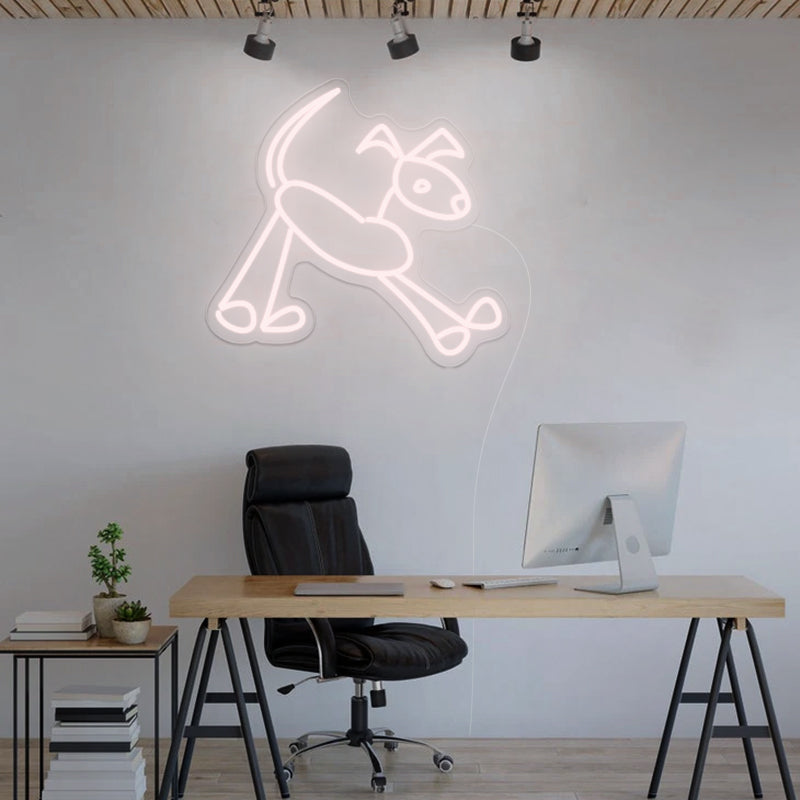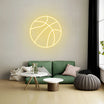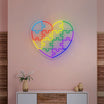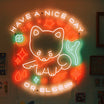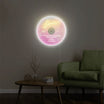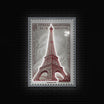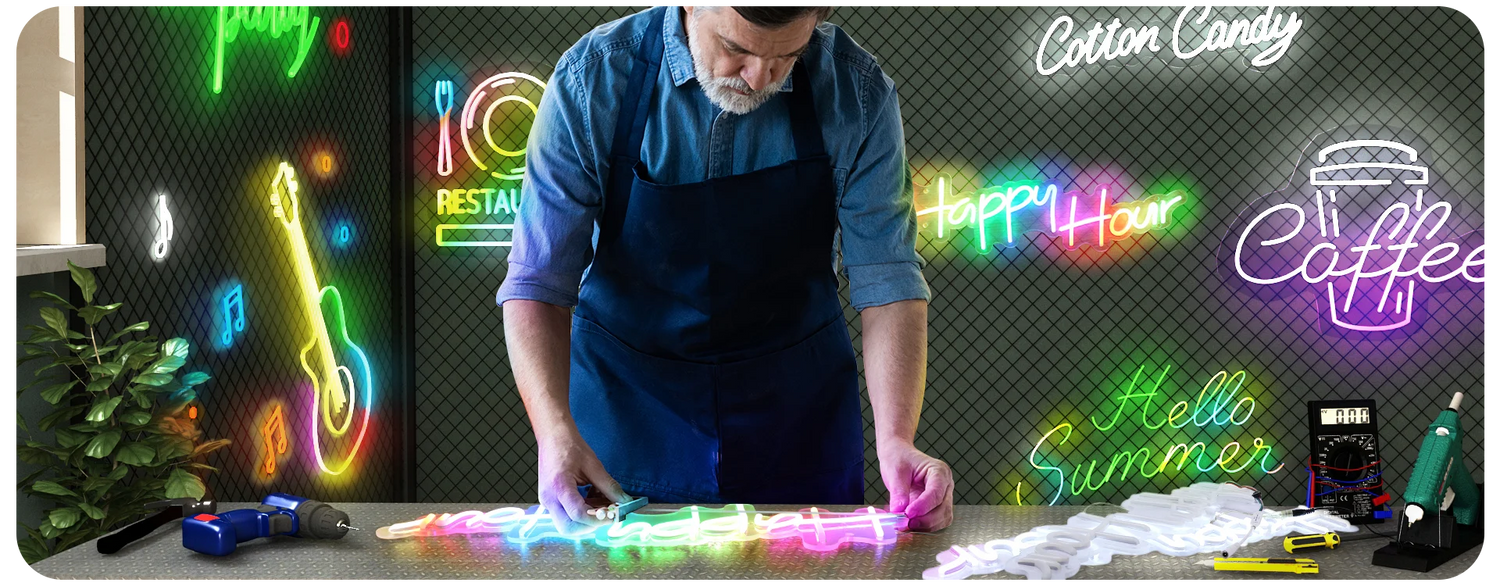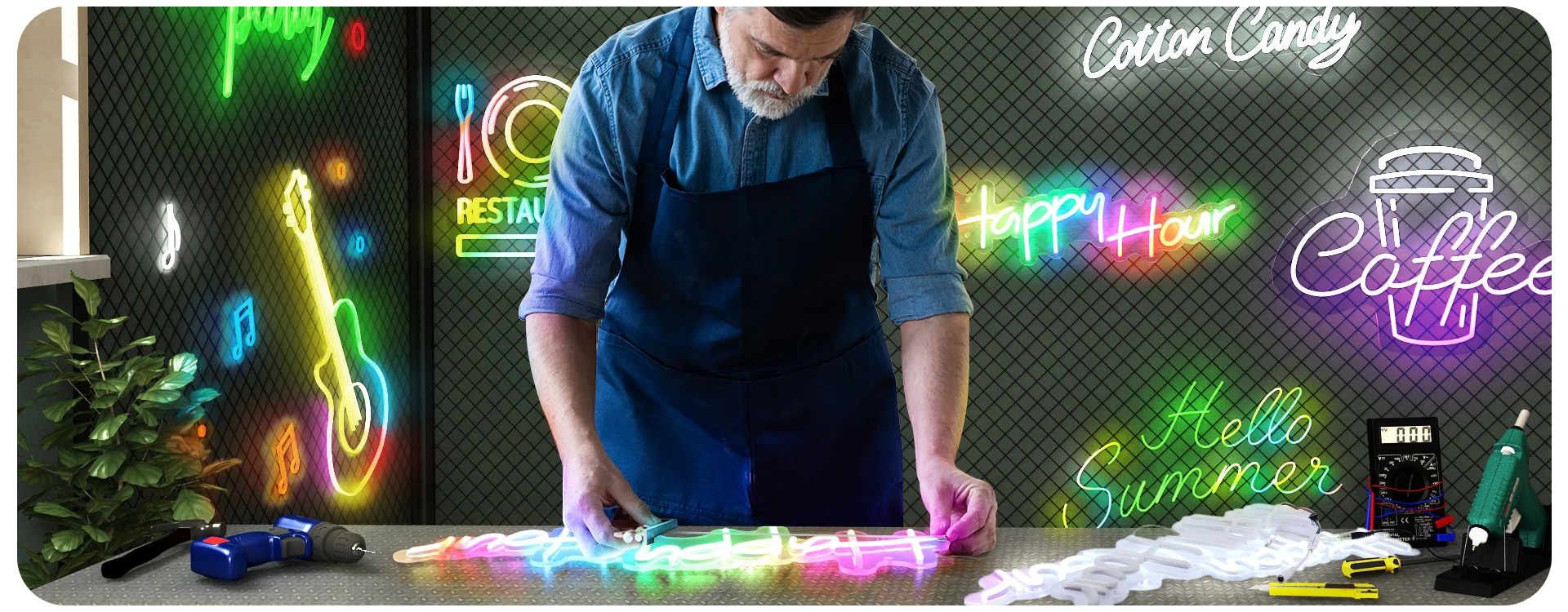The colours of neon lights
Neon lights have captivated our attention for decades with their dazzling and vibrant hues. Whether adorning a cityscape in the form of flashing neon signs, illuminated storefronts as business signs, or transforming an office into a luminous art space, neon lights have become synonymous with eye-catching brilliance. But what is the colour of a neon light and how is it produced? Have you ever wondered what creates the mesmerising array of neon colours? Let’s delve into the colourful world of neon lights and explore the fascinating science behind their famous glow.
What colour does neon light produce?
Neon lights were originally named after the noble gas “neon,” which emits a popular orange light when electrically stimulated. However, the term “neon light” has expanded to encompass lights created using other gases and chemicals, leading to a variety of colours. Each gas produces a distinct hue when subjected to an electric current:
- Neon: Emits a red glow.
- Helium: Produces an orange light.
- Argon: Illuminates in lavender, but when put into tubes with a green fluorescent coating, it gives off a green hue.
- Krypton: Glows gray or green.
- Mercury Vapor: Radiates a blue light.
In addition to using different gases, various colours can also be achieved by combining gases or adding chemical phosphors to the inside of the glass tube.
What makes neon lights different colours?
As mentioned above, the actual glow colour of neon signs is determined by a combination of gases and other factors. Let’s take a closer look at both aspects to give you the full colour scope.
-
Type of Gas: The primary determinant of neon light colour is the type of gas contained within the tube. While neon gas produces a specific hue, other noble gases can be used to achieve a variety of colours.
-
Tube Material and Coatings: The material of the tube and any coatings applied to its interior can influence the final colour emitted. This allows for further customization of the light’s appearance.
-
Gas Pressure and Temperature: Environmental factors like temperature and pressure also play a role in determining the shade and intensity of the neon light.
-
Amount of Gas: The quantity of gas within the tube can impact the exact hue produced. Neon signage can be fine-tuned to produce specific shades based on the gas concentration.
How neon light produces colour?
Neon lights derive their brilliant colors from a combination of gases and electrical discharge. The starting point is a glass tube, molded into various shapes or designs. Sealed within this tube are neon gas and sometimes other gases. Neon gas, when subjected to an electric current, emits a distinct orange hue.
However, neon lights can showcase a spectrum of colors, not just orange. This array of colors is achieved by adding different gases. For instance, argon produces a different color than neon. Beyond just the type of gas, another method to influence the color output is by coating the inner walls of the glass tube with fluorescent powders. When the gases inside are excited by electricity, they emit light which then interacts with these powders to produce various hues. The final color that we perceive is a result of the gas used, any inner coatings present, and the energy state of the excited atoms within the tube.
Factors affecting the colour of neon lights
Several elements come together to decide the vibrant spectrum of neon lights. The intricacies of temperature and pressure sway the shade and intensity of the light emitted. Diving deeper, it’s not just about the external environment, but the concoction of gases within and the surge of electrical current that weave this tapestry of hues.
Commercial neon signs, however, have an added layer of wizardry. The glass tubes can be coated to modify the wavelength of light emitted. This gives birth to a spectrum: the “Classic” hues — a direct manifestation of the gas mixture inside, and then there are the creations by Sygns. They’ve crafted two intriguing categories: “Powdered” — which seems white when dormant but unveils its colors when powered. In stark contrast, the “Coloured” series is unwavering, with tubes that don’t change their shade, on or off.
This mastery over multiple factors allows manufacturers to spawn a plethora of shades, catering to varied artistic desires and commercial requisites.
Neon light colors are affected by various factors. These include temperature, pressure, the gas composition inside the tubes, and the electrical current passed through. Additionally, manufacturers, like Sygns, leverage coatings within the glass tubing to further influence the emitted color. Such coatings can make the light appear white when off (Powdered) or maintain their hue both when on and off (Coloured). Thus, by manipulating these elements, an expansive color palette is made available for diverse needs.
How adding other gases can change the colour of neon lights
Neon lights are synonymous with their signature reddish-orange hue, which many of us recognize as the “Classic Red” neon color. But did you know that by introducing other gases to the mix, this iconic shade can be transformed into a spectrum of colors?
For instance, argon, when allowed to flow through these tubular light wonders, emanates a lavender hue. Add a hint of mercury, and you’ll witness the birth of a light blue discharge, affectionately termed as the “Classic Blue” color. But the dance of gases doesn’t end here. Bring helium into the fold, and the neon lights up with a brilliant shade of orange or even pink. Introduce krypton, and you’ll be graced with a pale white or an ethereal pale blue. Xenon, not to be left behind, paints the neon in cool blue strokes.
Radon, another member of the noble gas family, may have the potential to produce a vibrant red discharge. However, its radioactivity has understandably disqualified it from commercial ventures. Therefore, while it’s intriguing to imagine a neon universe painted with helium, krypton, xenon, and radon, neon and argon are the reigning champions in the commercial world. Their counterparts, though captivating in their own right, are sidelined due to factors such as high production costs or chemical properties that don’t make the cut in commercial endeavors.
Neon lights can achieve a wide range of colors by introducing different gases. Neon itself gives a reddish-orange glow. Argon emits lavender and can produce light blue with a touch of mercury. Helium brings forth bright orange or pink, krypton shows pale white or pale blue, and xenon offers a cool blue tint. Although radon has a vibrant red discharge, it’s not commercially viable due to its radioactivity. In commercial neon sign production, only neon and argon are primarily used, as other noble gases are often deemed inefficient due to factors like high costs and certain chemical properties.
Common colours of neon lights
Neon lights have graced our cityscapes and interiors with their vibrant luminosity for ages. Their spectrum is vast, each color bringing a different ambiance and mood. Let’s delve into some of the common shades that are part of many neon color collections:
Classic Red – This is the quintessential neon color, emanating from the natural glow of neon gas. It’s fiery, bold, and reminiscent of vintage signs or late-night diners.
Red neon lights, known for their warm and energetic aura, have been a staple in signage for over a century. This iconic red hue has been illuminating streets and establishments, signaling warmth, passion, and liveliness. Originating from early neon sign technologies that predate electricity, they peaked in popularity from the 1920s to the 1960s, the so-called “Golden Age of Neon.” Today, these radiant red beacons remain a testament to a rich legacy of combining science with visual allure, continuing to captivate onlookers and draw business attention.

Classic Blue – Achieved by combining argon with a touch of mercury, this hue brings calm, cool tones. Perfect for a relaxed vibe or evoking night skies.
Blue neon lights exude a sense of peace and serenity, making them a favored choice for locations aiming for a calming atmosphere, such as lounges. However, their adaptability is commendable. In certain settings, this very hue can encapsulate a futuristic aura, reminiscent of advanced tech settings or otherworldly domains. Hence, blue neon lights can both calm the soul and ignite the imagination, making them a versatile choice for varied environments.

Pale White or Pale Blue (from Krypton) – These shades are subtle, delicate, and ethereal. Ideal for a minimalist setup or where soft lighting is required.
White neon lights come in various shades, from cold, stark white to warm, creamy glows. Their lack of traditional color provides a sleek, clean aesthetic, perfect for modern and contemporary designs. These lights are frequently used for architectural highlights, adding a touch of elegance and modernity to structures. With their minimalist appeal, white neon lights are popular in spaces aiming for a clean, futuristic look without the overpowering presence of vibrant colors.

Lavender – This color, derived from pure argon, is both mysterious and elegant. It’s a hue that can transport you to serene fields of lavender or a magical twilight zone.
Purple neon signs uniquely combine mystery and energy, making them versatile additions to various spaces. Their sophisticated hue brings an element of luxury and intrigue, perfect for upscale settings. At the same time, their energetic undertones make them suitable for lively environments like nightclubs. Beyond their aesthetic appeal, purple neon lights also resonate with viewers on a deeper level, stimulating creativity and adding depth to artistic displays.

Bright Orange/Pink (from Helium) – Helium lights up the neon with a vivacious shade of orange or sometimes a pinkish hue. These colors are lively, energetic, and can add a touch of whimsy.
Orange neon lights stand as a beacon of energy and warmth in nightlife establishments. Their luminous glow not only attracts attention but also sets an upbeat and festive tone. The choice of this color, recognized for its vibrant and warm attributes, enhances the overall experience in bars, clubs, and entertainment venues. Whether it’s used to highlight a special event, accentuate a club’s name, or simply add a decorative touch, the orange hue of neon lights ensures a lively and inviting ambiance, promising a night filled with excitement and fun.

Pink neon lights, with their captivating and gentle radiance, are the epitome of charm and playfulness. Their association with romance, femininity, and tenderness makes them a go-to choice for a myriad of establishments, from boutique shops to trendy cafes and bars. These establishments leverage the romantic and youthful aura of pink neon to create spaces that are inviting, memorable, and in tune with the sensibilities of their audience. Whether it’s to showcase a brand’s unique character, set a romantic mood for an event, or simply add a touch of whimsy to an interior space, pink neon lights are a versatile and timeless decor choice that never fails to enchant.

Cool Blue (from Xenon) – A deeper shade than the classic blue, this hue brings in a touch of sophistication and modernity.
In the vast spectrum of neon colors, the “Cool Blue” derived from Xenon stands out as an emblem of elegance and contemporary flair. Distinctively deeper than the conventional blue neon lights, this shade resonates with an air of sophistication, drawing those who encounter it into its mesmerizing glow.
The deep, serene hue of Cool Blue evokes feelings of tranquility, reminiscent of the depths of the ocean or the twilight sky just before dusk. Its captivating brilliance is versatile, equally suited for upscale lounges, modern art installations, corporate settings, or chic urban lofts.
For businesses aiming to project a modern, sophisticated image, Cool Blue neon signs can serve as a visual anchor, reinforcing brand identity and drawing customers in. The shade’s modern vibe also makes it an ideal choice for tech companies or futuristic-themed events.
In interior design, a Cool Blue neon accent can transform a space, lending it a touch of modernity while also creating a calming ambiance. Whether it’s a statement wall piece, ambient room lighting, or accent decor, the depth of this hue offers a unique blend of style and serenity.

While these are just a few examples, the world of neon colors is vast and varied. Manufacturers often offer an extensive palette, ensuring that there’s a neon light to suit every mood, setting, and preference.
Neon lights come in a myriad of colors. Commonly, Classic Red is the natural shade of neon gas. Classic Blue is derived from argon with mercury. Lavender is pure argon’s hue, while helium can produce Bright Orange or Pink. Pale White or Pale Blue is the result of krypton, and xenon gives a Cool Blue tint. Each color has its ambiance, and the available spectrum ensures varied choices for different preferences.
The Magic Behind Neon: A Fusion of Science and Artistry
Neon lights, with their enthralling spectrum of colors, have truly transformed the domains of signage and artistic displays. These colors come to life due to meticulous crafting and shaping of neon glass tubes, a process that marries both science and art.
In our contemporary age, while there have been newer alternatives to neon signs thanks to advancements in modern signage technology, the allure of neon remains unparalleled. Neon lights not only illuminate spaces but also imbue them with a unique character and warmth, often becoming the focal point and talking piece of any establishment or decor.
To truly appreciate the magic of neon, one needs to delve into the intricate process of creating these luminous wonders. Every neon sign is a testament to the skill of its creator and the science behind its glow. So, when you see a neon sign, remember the craftsmanship that went into bringing those vibrant colors to life.
Our online Configurator is a gateway to understanding this artistry. It offers a deep dive into our neon color palette, allowing users to immerse themselves in the world of neon and appreciate the intricacies behind each shade.



